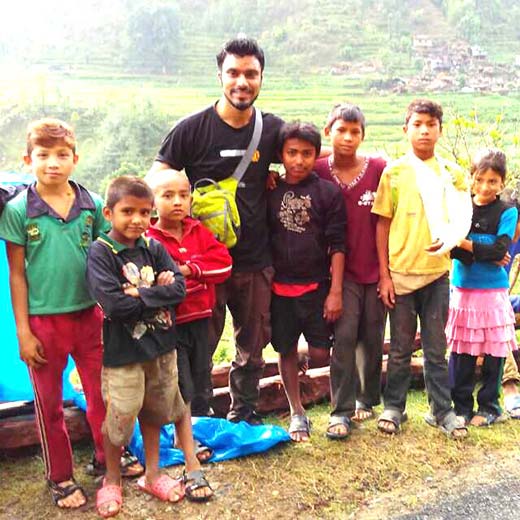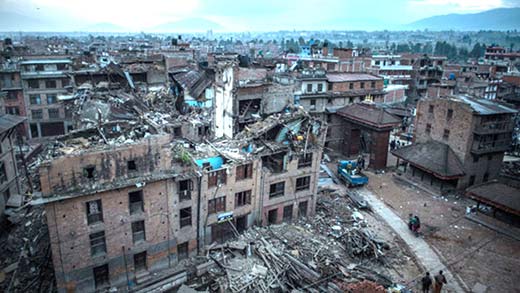Among thousands of volunteers busy helping Nepal come back to rails after the devastating earthquake, there are a few from Kashmir too. Engineer Abdul Wajid, who is still in Kathmandu, uses cellphone for sharing his experience

Nepal has been in the headlines since four weeks now. A deadly earthquake struck the country consuming more than 8000 lives. Being a social worker, I followed the news from the first day and was curious to reach out to the fateful people by all possible means. Someway I was correlating the restless state with that of Kashmir floods that was equally disturbing.
I tried reaching every possible organization that could help me reaching Nepal. Spending two sleepless nights, I wrote a dozen emails seeking for volunteering in Nepal. What kept me going was one chapter from Greg Montenson’s “Three Cups Of Tea” where the great philanthropist mentions writing over 500 emails and letters for three months before receiving one worthy response.
I finally got positive response from few international groups. With the help of some of the credible friends, I initiated a relief operation where I managed to collect some funds and relief material in collaboration with my company’s CSR team L&T Infotech.
I kept hunting for credible people and organizations active in Nepal work and got in touch with few. With all that accomplished, I was good to go.
One good thing for being an Indian, I mean as per the documents, is that you do not need a visa or passport for travelling to Nepal. And this was one good reason to feel happy about. Loaded with huge relief material and equally huge faith, I boarded my flight along with another volunteer and a doctor.
After the weary and sleepless 12 hour overnight journey, we reached Nepal. The rusty airport was festooned with sophisticated aircrafts from Indian air force, US and China, all circulating Nepal for relief work.
I was received by one Nepali team that guided our baggage to one base camp in Kathmandu.
The capital looked very fine and not as pictured by the media. I could smell the hatred towards Indian media. I had to resist temptations and of reporting openly, although I was observing inspiring stories around.
On my first day, I met one enthusiastic local youth volunteer, Sali Dewan and his team comprising of some local and international volunteers from USA, Brazil and Germany.
I joined the team and headed for Sindhupal Chowk district, the worst hit area of Nepal. Reaching the disastrous place was not easy without Sali. His team of young volunteers fuelled the work with their hard work and dedication. The village looked very beautiful but equally devastating.
On one side, the natural scenery captured my imaginations but on the other side, the destruction was repelling. Ninety percent of houses were damaged. Sali introduced me to Rishi, who lost 4 of his family members to the deadly tremors. He looked numb but still entertained the sympathizers with humility.
I visited few more villages like Dolakha and Cziri, close to china border. I could see a cavalcade of Chinese trucks fetching relief from China. Interestingly there was an impressive ‘China effect’ everywhere — Red Cross China, Chinese army, etc.
The first few days before my arrival were even worse. My volunteer mate Anil says he saw 500 unidentified dead bodies in army camp to be cremated. He introduced me to one young lady, Kamla who lost 18 family members from her joint family.
Despite she was still there with our team to volunteer. Kamla believes her pain is nothing as compared to others who lost everything. She painfully recollects the tragic time when all her family was hit. Her sister in law, 8 month pregnant, buried under the rubble, succumbed after her 4 hours wailing failed to seek any help.
Working with Sali was a good experience. He is immature but a perfect leader, a carefree guy, but very mindful and compassionate. “My team has a positive and a negative. Negative is that we are not pro but the positive is that we work better than the pro,” says Sali before cracking his incredible laughter. That summed up my day one.

Day two was simply bad, but lucky. The already paralyzed land was stuck with another ugly earthquake of a greater magnitude. It was 7.3 and I was lucky enough to survive.
I was there at the epicenter a day before with Sali and his team.
Moreover I was on the way to the same place before something happened and I delayed my travel. Otherwise it would had been tragic. Lucky!
I could feel the earth shaking badly under my feet. All the buildings started wobbling. In no time there was chaos. I ran toward the camp to help the aunty with a fractured leg whom I met a day before. She was struggling to get down the stairs with her little kids terribly frightened.
That fear was freaking. I and one more friend rescued her to an open ground. Later my team helped with constructing one tent that eventually sheltered around 30 people and became our resting place for next few days.
Later I signed off my day and slept in open air until another jolt hit in the middle of a dead night. It was again frightening.
People were out and awake all night, freaked! I could feel the fear around. I felt so sorry for people sleeping on streets despite possessing grand houses like those we have in Kashmir.
The following day, things were at halt. I was stuck in Kathmandu because the roads to villages were not reachable as a result of dry avalanches following the last earthquake.
While in Kathmandu, I started exploring the relief organizations and volunteers. I met one professional volunteer from HCI (Himalayan Climate Initiative) named Pradip and his co volunteer Dr Kripa Mahajan. The duo mentored me in getting a better picture of the situation. Thanks to Dr Kripa, I was able to roam and explore all the affected places around Kathmandu.
I tried to seek Kashmiris people working in Nepal and talk to them.
Dr Kripa guided me to a Jamia mosque interestingly named Kashmiri mosque situated in Ganta Ghar area of Kathmandu. My curiosity increased to explore more.
I met the head of the mosque, Sajid Shah, who briefed about the history of the grand mosque saying the mosque is believed to been constructed some 470 years ago by five Kashmiri immigrant families whose tomb is currently there.
Regarding the current situation, Sajid attested to support many Kashmiri people during earthquake.
Unfortunately I could not meet any Kashmiri fellow since most of them have returned to the valley following the earthquake and the thin business because of the tremor.
Before returning to my base camp, I visited Thamil, the Pahad Gunj of Nepal, where I met few journalist friends and volunteers. I wanted to make sure I connect all the people I know before I leave and empower them to solve the problem in unison.
Next day I winded up from Kathmandu and moved to Porkha, the most famous tourist place in Nepal.
It was a weary 6 hour bus journey into the beautiful place reminding me of Jammu-Srinagar highway. Sali runs a garment shop in the main market.
Interestingly there are more than 100 Kashmiri shops in the market. But again, most of them have fled to valley.
Sali attested the great business skills of Kashmiris: “Kashmiris are the smartest people I have met. They do smart business and have expertise in learning new languages. They are the richest businessmen here.”
Currently, I am staying close to Lake Fewa in Pokhra and for the first time since my arrival I felt like a delighted tourist. I felt relaxed. This place seems totally different and peaceful compared to the ugly face of other Nepal.
And now my next relief operation is in Gorkha district, 3 hours trek from Pokhra. The plan is to collaborate with a village of more than 1000 people and rebuild three schools of 700 kids. My team is focusing on rebuilding the schools and temporary shelter with the help of villagers while empowering them by providing the labour work. My stay will conclude with that.
And now when I am returning back tomorrow, I wish to stay back and rejoice the normalcy. But then I have to go, so has the tragedy. All the international helpers and NGOs have to leave. All the gloominess will decimate. What will remain is the determined local volunteering and their strong faith much like the huge Everest, the Sagarmatha, that stands tall. Let’s rebuild Nepal.
(Abdul Wajid is former Kashmir Life staffer)















